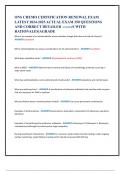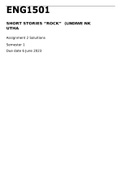ONS CHEMO CERTIFICATION RENEWAL EXAM
LATEST 2024-2025 ACTUAL EXAM 350 QUESTIONS
AND CORRECT DETAILED ANSWERS WITH
RATIONALES|AGRADE
What is an example of an antimetabolite whose toxicities change with dose and rate of infusion? -
ANSWER-Cytarabine
Which antimetabolite has unique considerations for SC administration? - ANSWER-Azacitidine
What does azacitidine treat? - ANSWER-Myelodysplastic syndrome (MDS)
What is MDS? - ANSWER-Abnormal bone marrow and blood cell morphology, primarily occurring in
older white males
What two antimetabolites can be administered intrathecally? - ANSWER-Cytarabine and methotrexate
What are anthracyclines? - ANSWER-A classification of antitumor antibiotics that interfere with enzymes
that are necessary for DNA to replicate
Why are lifetime doses of anthracyclines limited? - ANSWER-Can cause permanent cardiotoxicity
Examples of anthracyclines - ANSWER-Daunorubicin, doxorubicin, doxorubicin Hcl liposomal, epirubicin,
idarubicin
Examples of nonanthracycline antitumor antibiotics - ANSWER-Actinomycin D, Mitomycin C, Bleomycin,
mitoxantrone (although has anthracycline-type properties)
Nursing teaching for doxorubicin - ANSWER-Is a vesicant, needs cardiac function testing, needs ongoing
cardiac monitoring, needs lifedose tracking which should not exceed 450-550 mg
,What is a cardiac protectant sometimes administered with doxorubicin? - ANSWER-Dexrazoxane
Side effects of doxorubicin - ANSWER-Cardiotoxicity, N/V/D, mucositis, severe myelosuppression,
hepatic impairment, secondary cancers
Features of Doxorubicin HCl Liposomal - ANSWER-Encapsulated in lipsomes that have an additional
glycol sheath that protects liposomes from being detected and destroyed by phagocytes in blood (aka
pegylation) which increases the drug's blood circulation time; not a vesicant, is an irritant; same cardiac
precautions as doxorubicin
Features of bleomycin - ANSWER-An antitumor antibiotic, has a lifetime warning of 400 units for
pulmonary fibrosis
Which type of cancer has a higher risk of anaphylaxis with bleomycin? - ANSWER-Lymphoma
Side effects of bleomycin - ANSWER-Pulmonary fibrosis, hypersensitivity reactions, cutaneous reactions
When are patients who receive bleomycin at risk for pulmonary toxicity? - ANSWER-When given oxygen
during surgery; alert providers before any procedures
What happens to the heart when anthracyclines cause cardiotoxicity? - ANSWER-First a subtle EKG
change, then cardiomyopathy, then heart failure
Risk factors for CINV? - ANSWER-Young, history of low/no alcohol consumption, female, hx morning
sickness during pregnancy, prone to motion sickness, hx chemo
Acute CINV - ANSWER-within 24 hours of chemo
Delayed CINV - ANSWER-Within 24hr-5 days of treatment
Breakthrough CINV - ANSWER-Occurs despite treatment
, Anticipatory CINV - ANSWER-Triggered by taste, odor, memories, visions, or anxiety related to
chemotherapy
Refractory CINV - ANSWER-occurring during subsequent cycles when treatment failed in earlier cycles
HEC Chemos (90% of patients) - ANSWER-Carmustine, cisplatin, cyclophosphamide, dacarbazine,
mechlorethamine, streptozocin
MEC agents (30%-90% of patients) - ANSWER-Carboplatin, cytarabine, daunorubicin, doxorubicin,
epirubicin, idarubicin, ifosfamide, irinotecan
Low CINV risk agents (10%-30%) - ANSWER-5-FU, cytarabine, docetaxel, gemcitabine, methotrexate,
mitomycin c, mitoxantrone, paclitaxel, pemetrexed
Minimal risk CINV agents (<10%) - ANSWER-bleomycin, bevacizumab, bortezomib, busulfan, cetuximab,
fludarabine, trastuzumab, vinca alkaloids
What type of agents usually cause cutaneous reactions? - ANSWER-EGFR inhibitor therapies
Which antimetabolites have been found to cause cutaneous reactions? - ANSWER-5-FU and
capecitabine (Xeloda)
Symptoms of palmar plantar erythrodysesthesia - ANSWER-Flaking, swelling, small blisters, small sores
What to avoid with palmar planta erythrodysesthesia - ANSWER-Hot water, impact on feet, use of tools
that require squeezing, rubbing
What is the most common dose-limiting toxicity that can be lethal if uncontrolled? -
ANSWERMyelosuppression





